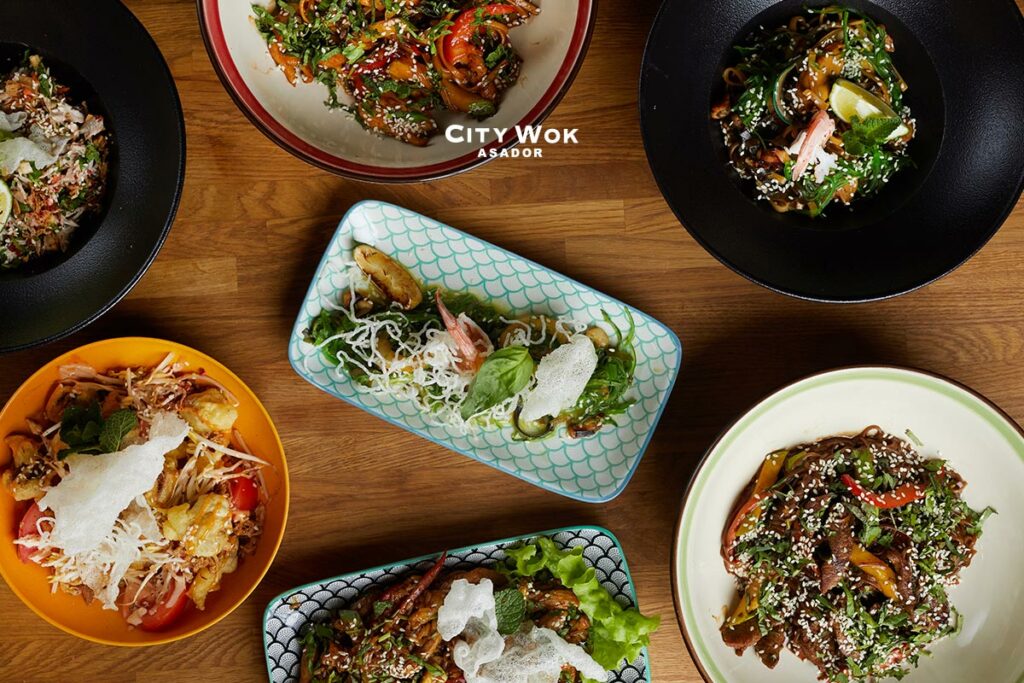Platos típicos de la gastronomía oriental

¿Sabes cuáles son los platos más típicos de la gastronomía oriental? En el post de hoy te hablamos de ellos, para que así descubras platos nuevos para probar.
China tiene una larga historia y la cocina oriental es una parte importante de su cultura. Los platos tradicionales chinos son famosos por su color, aroma, sabor y apariencia.
¡En Asador City Wok hemos seleccionado los platos más típicos de la gastronomía oriental!
Hotpot
Es un plato para los verdaderos amantes de la comida oriental. Consiste principalmente en cocinar distintos alimentos en un calco caliente con diferentes salsas y colocarlo en el centro de la mesa. Suele incluir carne, verduras, wantanes, huevo, setas y a veces incluyen mariscos. Hay cientos de tipos y puedes encontrar muchas variantes de este plato.
Carne de cerdo agridulce
La carne de cerdo agridulce es tradicional de la cocina oriental, y actualmente se ha hecho famosa internacionalmente por su gran demanda en menús de restaurantes chinos. Este plato al principio solo se realizaba de carne de cerdo, pero actualmente se ha sustituido por otros ingredientes como pollo, ternera o costillas de cerdo.
Tofu picante
Este plato es uno de los platos más famosos de la cocina de Chuan, con una historia de más de 100 años. Mapo Doufu es una combinación de tofu con salsa roja picante. A veces este plato de la gastronomía oriental aparece cubierto con carne picada de ternera o cerdo.
Jiaozi
Este plato es un alimento tradicional muy popular en el norte de China. Jiaozi consiste en carne y verduras picadas envueltas en una fina piel de masa. Se cocina de diferentes formas: hervidos o fritos y acompañado de salsa de soja y vinagre o salsa picante.
Rollitos de primavera
Es un rollo de pasta relleno de carne picada y verduras cortadas. En China suelen comérselo de aperitivo durante la Fiesta de la Primavera. Al tener una apariencia de barras de oro, se le suele relacionar con ideas de riqueza.
Zongzi
Este plato tradicional de la gastronomía oriental, se elabora principalmente con arroz glutinoso con diferentes rellenos y enrollado con hojas de bambú. La técnica para envolver las hojas de bambú y la receta suelen heredarse de unas familias a otras, por lo que hay distintas formas de elaborar un Zongzi. Además, este plato puede elaborarse también de distintas formas, por ejemplo a vapor o hervido.
Sopa wan tan
Una de las sopas de la gastronomía oriental más famosa mundialmente. Este plato está elaborado de una masa de harina de trigo, rellena principalmente de verduras, camarones y carne de cerdo. Además, suele comerse con fideos finos y cebolla china.
Pollo gong bao o kung pao
Este plato es clásico de la cocina Sichuan, originario de la provincia de Sichuan por la parte central del oeste de China. El pollo gong bao es uno de los platos más picantes de la gastronomía oriental.
La base de este plato es el pollo y en la receta tradicional se sofríen guindillas y pimienta de Sichuan para que así el aceite recoja las fragancias de las especias. En cambio, en la receta occidental se le añade cacahuetes, pimientos verdes, salsa hoisin, vino de arroz, salsa de ostras y chili.
Chow mein
Uno de los platos más versátiles de la cocina oriental, ya que todo lo que lleve fideos fritos se le llama Chow Mein. A este plato se le puede añadir ingredientes variados, pero lo más habitual es que contenga: carne, repollo, fideos y otras verduras.
Esperamos desde Asador City Wok que te haya servido este post y conozcas nuevos platos típicos de la cocina oriental. En nuestro restaurante puedes encontrar una gran variedad de comida oriental y como es un buffet ¡puedes probarlos todos!